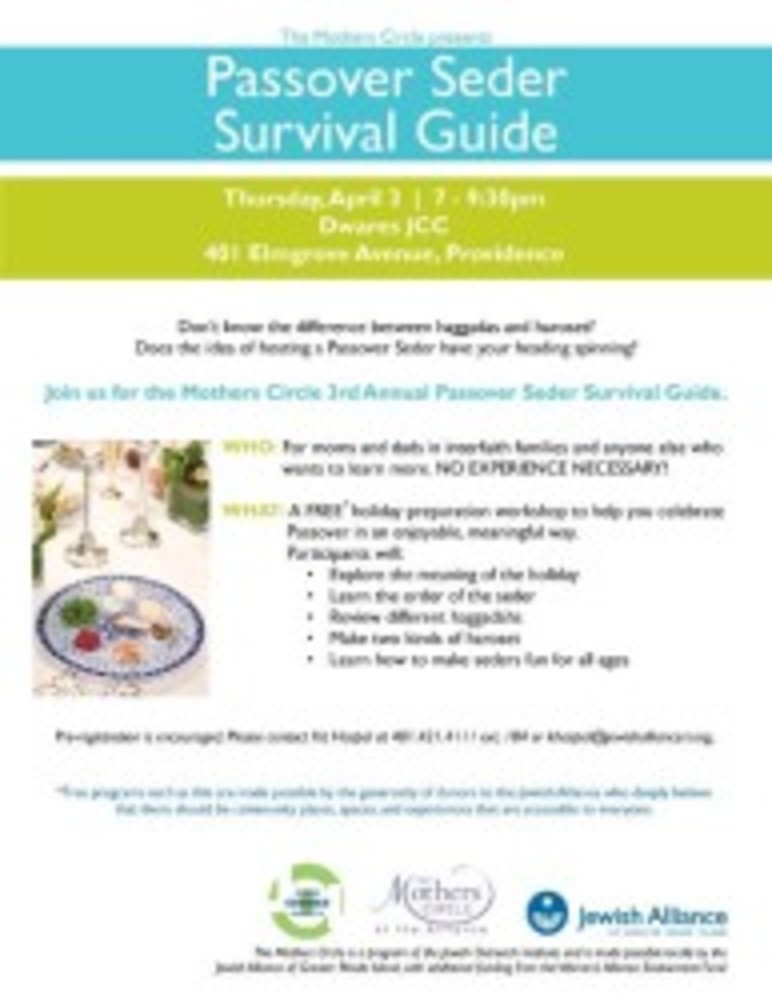Passover Seder Survival Guide
Explore the holiday and prepare for your celebration

Anyone in my family would tell you I’m not much of a cook. There was the big dinner when I forgot to turn on the oven; and then there was the time I strained the chicken soup directly into the sink rather than back into the pot, thus losing all the broth. But the one time a year I cook a meal start to finish, and even take days to do it, is for the Passover Seder. Beginning when my children were very young, it was important to me to have a real Seder every year. I have learned since that this is not unusual; Passover is the most celebrated of all the Jewish holidays. And you can’t do a Seder without a meal.
I’ve learned a lot about Jewish life, even if not so much about cooking, since my children were young, but my Passover meal has remained very much the same. As I tell the women in Mothers Circle as they are learning about Jewish traditions for the first time, there is something about having the same foods as well as the same smells that makes a tradition. Years ago, I picked a honey-orange chicken dish that looked easy to make from Joan Nathan’s “Jewish Holiday Kitchen.” Although not necessarily the most traditional Seder dish, I think if I served something else now, it wouldn’t feel like Passover to my family.
There is a fair amount of flexibility in the food you serve, but there are also foods we cannot eat, referred to as chametz. Most of us know that we cannot eat anything that is leavened because when the Israelites were fleeing Egypt during the Exodus, they did not have time for the bread to rise. In addition to leavening agents like yeast and sourdough, we cannot eat wheat, barley, rye, oats and spelt because when these grains come into contact with water, they rise.
Since matzah is also made from wheat, this is a bit confusing. The difference is that the process of making matzah is carefully supervised so that no more than 18 minutes elapses from the time water touches the flour until the matzah is baked.
The food rules are even more strict for Ashkenazi Jews (Jews originally from Eastern Europe, as opposed to North Africa and the Middle East). In addition to the five grains and leavening agents, they avoid a category of food called kitniyot, which includes rice, corn, millet and legumes. It is unclear why these foods came to be forbidden, but one theory is that they expand when in contact with water and thus appear to rise.
But there are also all kinds of foods that can be eaten, and many have come to be traditional at the Seder table. Matzah ball soup is one, as are gefilte fish and matzah kugel. There are also foods that are part of the Seder service and found on the Seder plate, such as horseradish, parsley and haroset.
Haroset, a fruit and nut mixture said to represent the mortar used by the Hebrew slaves in the making of bricks, comes in innumerable varieties. The traditional Ashkenazi haroset is made from apples and walnuts. But there are almost as many Sephardic recipes as there were towns in the Sephardic world.
At the Passover Seder Survival Guide (a free workshop for parents in interfaith families and anyone else who wants to learn more) on April 3, we will make two different kinds of haroset. Our Sephardic recipe uses dates, bananas, pistachios and almonds.
At the Passover Seder Survival Guide, we will also review the story of Passover, learn the order of the seder, explore ways to make the seder fun and meaningful for participants of all ages and have an opportunity to review different haggadaot, the books that serve as the guide to the seder.
KIT HASPEL is the Director of Interfaith Outreach at the Alliance. The Passover Seder Survival Guide is a program of the Jewish Outreach Institute and is funded locally by the Alliance with additional funding from the Women’s Alliance Endowment Fund.
FOR MORE INFORMATION about the Passover Seder Survival Guide, contact Kit Haspel at 421-4111, ext. 184.







